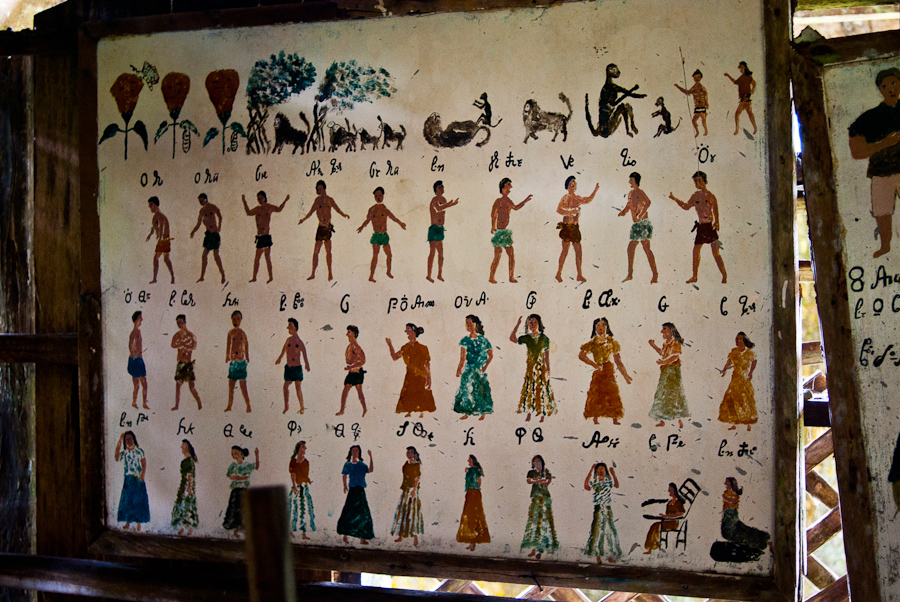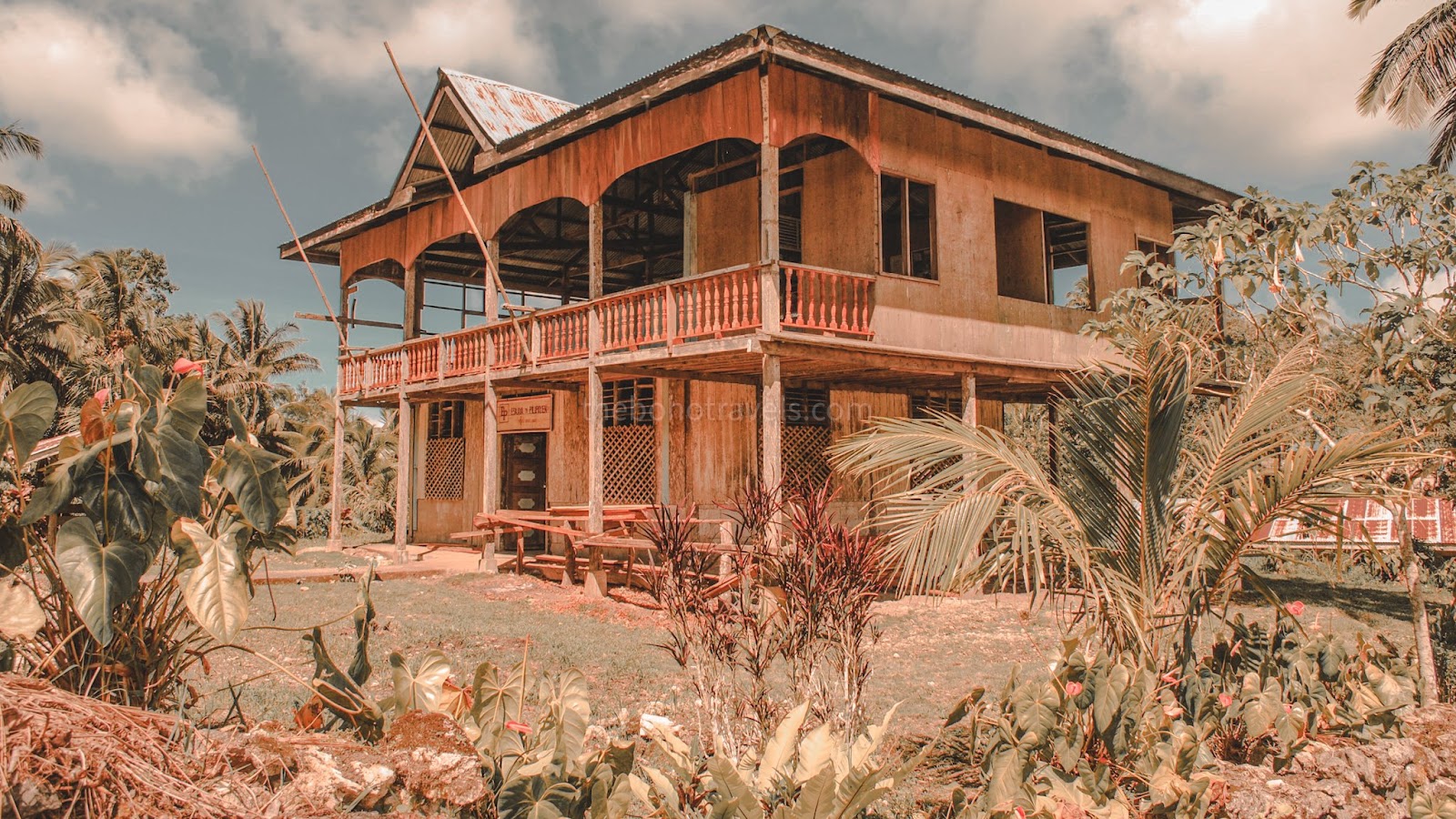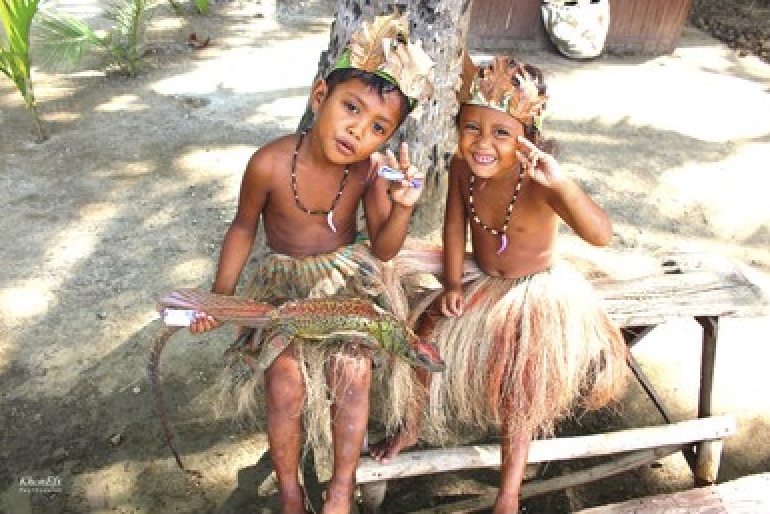Muyhtologies of the Eskaya Tribe
The Eskaya Tribe is located on Bohol, an island in the Southern Philippines. According to the last census in 2000 it had a population of around 3000. They live in a few villages in the mountains and along the coast. The Eskaya have a unique language and writing system that scholars have not been able to link to any other known language. They also have a unique oral history (or mythology depending on who you ask) dating back to biblical times. They believe that people originated from a butterfly called Pinya Paypay Pling. In some way (that is not clear to me) the butterfly interacted with a lion and lioness who gave birth to a monkey. That monkey mated with another and gave birth to the first humans. This is depicted in this educational chart from their school. Their written characters are based on parts of the body, as can be seen in this hand-carved wooden depiction. Both their history and their language are recorded in a series of hand-written volumes. What is left of this tribe’s unique culture is passed on through a few schools like this one in the mountains. As in many rural tribes in the Philippines, the attractions of technology and modernism are drawing young people away from tradition and out of their villages, slowly eroding the local culture. Before long, all that will be left of these cultures are the few books that have been written.
The Eskaya, less commonly known as the Visayan-Eskaya, is the collective name for the members of a cultural minority found in Bohol, Philippines, which is distinguished by its cultural heritage, particularly its literature, language, dress and religious observances. After the Eskaya first came to public attention in 1980, these cultural practices were the subject of intense speculation on the part of local journalists and amateur historians who made diverse claims about the ethnolinguistic status of the Eskaya people. The unique Eskayan language and writing system in particular has been a source of fascination and controversy. Some journalists argued that the Eskaya were historically displaced from the Middle East, while others suggested that the community was a cult speaking an invented language. According to Eskaya mythology, the language and script was created through divine inspiration by the ancestor Pinay who based it on the human body. Suppressed by the Spanish colonists, Pinay's language was said to have resurfaced under the leadership of Mariano Datahan (ca. 1875– January 17, 1949), a veteran of Bohol's republican army. Although the historical existence of Pinay cannot be confirmed, more recent studies that combined linguistic analysis with oral history and genealogical research provide evidence that the Eskaya language was most likely created and disseminated within a generation by a charismatic individual. Today, the Eskaya are officially classified as an Indigenous Cultural Community under The Indigenous Peoples' Rights Act of 1997 (Republic Act No. 8371). A number of reports have suggested that Eskaya linguistic and cultural education has been in steady decline since the mid-1980s, although promising revitalisation efforts have also been documented. Most members of the Eskaya community inhabit a mountainous area that intersects the municipalities of Duero, Guindulman, Pilar and Sierra Bullones in the once-forested region of Bohol's southeast interior. The original Eskaya settlement in Biabas (Guindulman), was established in 1902. In 1951, the second township of Taytay (municipality of Duero) was founded by Fabian Baja in accordance with Datahan's directions. Significant Eskaya populations are now also found in the nearby townships of Canta-ub, Lundag, Tambongan, Cadapdapan, and Fatimah. In 1996, the Eskaya community was awarded a certificate of Ancestral Domain Claim by President Fidel Ramos. An official census of the Eskaya population has not yet been made. One report estimates that in 1991 there were 130 Eskaya families living in Bohol.
Tribu Eskaya is one of the less visited place in Bohol. They are an indigenous group found in the towns of Duero, Guindulman, Sierra Bullones, and Pilar. The tribe has its own distinct culture, literature, and language. The most common settlement of the tribe is located in barangay Taytay, Duero, Bohol. There are many controversies and stories regarding the history of the tribe. Most of it based on stories passed down from generations to generations. The most detailed that is so near of what our guide has shared to us can be read here http://www.bohol-philippines.com/history-of-eskaya.html . On the other note, the Eskaya Tribe in Duero, Bohol was founded by Fabian, Baja under the instructions of Mariano Datahan. Mariano Datahan established the very first Eskaya Tribe in the 20th century in Biabas, Guindulman, Bohol. Pinay is the one man who devised the writing system of the Eskaya Tribe. They said that it is based from parts of the human body and positions of a man’s head, arms, and legs. According to some linguists the Eskaya language is pure syllabary much like the Japanese Katakana.

The Eskaya is an indigenous tribe found in the hinterlands of the towns of Duero, Guindulman, Pilar and Sierra Bullones, Bohol’s southeast interior. The settlement of this tribe is at Biabas, Guindulman, established in the early 20th century by one Mariano Datahan. Datahan died in the year 1949. A second settlement was established at Taytay, under the municipality of Duero in the year 1951; founded by Fabian Baja under Datahan’s instructions. Eventually, the group spread to nearby Canta-ub, Lundag, Tambongan, Cadapdapan and Fatimah. Likewise known as the “Visayan-Eskaya”, the community is only found in the island province of Bohol. They have a unique cultural heritage, use a distinct language and literature, and have traditional practices that dates way back to pre-Spanish times. Eventually, the group was recognized and the community awarded a Certificate of Ancestral Domain Claim (CADC) in 1996 by President Fidel V. Ramos. CADC No. R7-CADC-14 deemed as ancestral domain 3,173 hectares of land in Taytay (Duero), Biabas (Guindulman), Lundag (Pilar), Canta-ub (Sierra-Bullones), and Cadapdapan (Candijay). Legally, the Eskaya are now classified as an indigenous group under Republic Act or R.A. No. 8371 entitled “The Indigenous People’s Rights Act of 1997. No official census has yet been made of the group but a report in 1991 mentioned 130 Eskaya families living in Bohol. Although the group’s distinct culture, literature and language has baffled historians over the years, some of these traditional practices are no longer strictly imposed on the younger generations. A decline in the community’s linguistic and cultural education has been noted. The Eskaya tribe all converted to the Philippine Independent Church under the direction of Mariano Datahan in 1902. They revered a supreme being which they called by the name “Suno” and attended weekly church services. The religious community was headed by a bishop whom they call “biki” and “beriki”. These spiritual leaders also performed rituals for good harvests, house blessings, weddings and the like aside from the weekly services. An Eskaya cannot construct a home without going thru a distinct process. Thru a ritual, the biki has to ask first the permission of the spirits if the site for the house is ok or not. If permission is not granted, one has to select another site and undergo another ritual until permission is granted. At weddings, the parents of the bride offer the couple a glass of water and a comb. The comb is dipped in the water and run through the hair of both bride and groom, believing that in doing so, both will remain calm and cool throughout their marriage. Afterwards, rice is showered on the couple assuring them of material wealth. This practice is still being observed, not only by the Eskaya, but also by some Boholanos.
The Last Language on Earth examines the origins and history of the Eskayan language, spoken today by an upland community on the island of Bohol in the southern Philippines. Using linguistic, ethnographic and historical lines of investigation, the new book engages directly with the Eskayan language itself, as well as the direct perspectives of those who use it today. In 1980, journalists announced the ‘discovery’ of a ‘lost tribe’ on the island of Bohol, Philippines. Speculation about the origins of the group, known as the Eskaya, began almost immediately, with visitors grasping to account for the people’s unique language, dress and beliefs. Some proposed that the Eskaya were descended from Etruscans, or a lost tribe of Israel. Others even accused the group of a hoax, suggesting that they had fabricated their language to attract government support. But recent research published by Oxford University Press is shedding new light on the enigma. “I tried to probe the Eskayan language to see what it might reveal about its own history,” says Dr. Piers Kelly, a linguistic anthropologist at the University of New England, Australia, and affiliated with the Max Planck Institute for the Science of Human History in Germany. “But I also wanted to listen to historical perspectives offered by Eskayan speakers today.” Spoken Eskayan bears little resemblance to Visayan, the native language of the island’s other inhabitants. What’s more, it is written in a complex script of more than one thousand signs. Over several years, Kelly lived and worked alongside Eskaya people, recording their language, literature and writing system. “The Eskayan language is a riddle,” Kelly concedes. “Its grammar is similar to major Philippine languages, yet most of its vocabulary is a mystery. At a foundational level there is a surprising influence from Spanish and English that can’t be explained through normal borrowing. The symbols belonging to its complex writing system can represent whole words, single syllables, individual letters or a combination.” Kelly’s linguistic analysis corroborates elements of a traditional story that says that the Eskayan language was intentionally created from scratch. In this popular account, the language and script were both fashioned from the body of an ancestral prophet, and later restored to use in the 20th century by an anti-colonial rebel.
The Eskaya, less commonly known as the Visayan-Eskaya, is the collective name for the members of a cultural minority found in Bohol, Philippines, which is distinguished by its cultural heritage, particularly its literature, language, dress and religious observances. After the Eskaya first came to public attention in 1980, these cultural practices were the subject of intense speculation on the part of local journalists and amateur historians who made diverse claims about the ethnolinguistic status of the Eskaya people. The unique Eskayan language and writing system in particular has been a source of fascination and controversy. Some journalists argued that the Eskaya were historically displaced from the Middle East, while others suggested that the community was a cult speaking an invented language. According to Eskaya mythology, the language and script was created through divine inspiration by the ancestor Pinay who based it on the human body. Suppressed by the Spanish colonists, Pinay's language was said to have resurfaced under the leadership of Mariano Datahan (ca. 1875–January 17,1949), a veteran of Bohol's republican army. Although the historical existence of Pinay cannot be confirmed, more recent studies that combined linguistic analysis with oral history and genealogical research provide evidence that the Eskaya language was most likely created and disseminated within a generation by a charismatic individual. Today, the Eskaya are officially classified as an Indigenous Cultural Community under The Indigenous Peoples' Rights Act of 1997 (Republic Act No. 8371). A number of reports have suggested that Eskaya linguistic and cultural education has been in steady decline since the mid-1980s, although promising revitalisation efforts have also been documented.





















Comments
Post a Comment